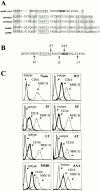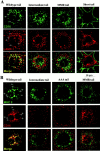The dendritic cell receptor for endocytosis, DEC-205, can recycle and enhance antigen presentation via major histocompatibility complex class II-positive lysosomal compartments
- PMID: 11062267
- PMCID: PMC2185598
- DOI: 10.1083/jcb.151.3.673
The dendritic cell receptor for endocytosis, DEC-205, can recycle and enhance antigen presentation via major histocompatibility complex class II-positive lysosomal compartments
Abstract
Many receptors for endocytosis recycle into and out of cells through early endosomes. We now find in dendritic cells that the DEC-205 multilectin receptor targets late endosomes or lysosomes rich in major histocompatibility complex class II (MHC II) products, whereas the homologous macrophage mannose receptor (MMR), as expected, is found in more peripheral endosomes. To analyze this finding, the cytosolic tails of DEC-205 and MMR were fused to the external domain of the CD16 Fcgamma receptor and studied in stable L cell transfectants. The two cytosolic domains each mediated rapid uptake of human immunoglobulin (Ig)G followed by recycling of intact CD16 to the cell surface. However, the DEC-205 tail recycled the CD16 through MHC II-positive late endosomal/lysosomal vacuoles and also mediated a 100-fold increase in antigen presentation. The mechanism of late endosomal targeting, which occurred in the absence of human IgG, involved two functional regions: a membrane-proximal region with a coated pit sequence for uptake, and a distal region with an EDE triad for the unusual deeper targeting. Therefore, the DEC-205 cytosolic domain mediates a new pathway of receptor-mediated endocytosis that entails efficient recycling through late endosomes and a greatly enhanced efficiency of antigen presentation to CD4(+) T cells.
Figures







Similar articles
-
Targeting of DEC-205 on human dendritic cells results in efficient MHC class II-restricted antigen presentation.Blood. 2010 Sep 30;116(13):2277-85. doi: 10.1182/blood-2010-02-268425. Epub 2010 Jun 21. Blood. 2010. PMID: 20566893
-
Efficient targeting of protein antigen to the dendritic cell receptor DEC-205 in the steady state leads to antigen presentation on major histocompatibility complex class I products and peripheral CD8+ T cell tolerance.J Exp Med. 2002 Dec 16;196(12):1627-38. doi: 10.1084/jem.20021598. J Exp Med. 2002. PMID: 12486105 Free PMC article.
-
Internalization and endosomal degradation of receptor-bound antigens regulate the efficiency of cross presentation by human dendritic cells.Blood. 2012 Sep 6;120(10):2011-20. doi: 10.1182/blood-2012-01-402370. Epub 2012 Jul 12. Blood. 2012. PMID: 22791285
-
Endosomal sorting of MHC class II determines antigen presentation by dendritic cells.Curr Opin Cell Biol. 2008 Aug;20(4):437-44. doi: 10.1016/j.ceb.2008.05.011. Epub 2008 Jul 5. Curr Opin Cell Biol. 2008. PMID: 18582577 Review.
-
MHC class II antigen presentation by dendritic cells regulated through endosomal sorting.Cold Spring Harb Perspect Biol. 2013 Dec 1;5(12):a016873. doi: 10.1101/cshperspect.a016873. Cold Spring Harb Perspect Biol. 2013. PMID: 24296169 Free PMC article. Review.
Cited by
-
DNA vaccines encoding DEC205-targeted antigens: immunity or tolerance?Immunology. 2015 Aug;145(4):519-33. doi: 10.1111/imm.12467. Epub 2015 Apr 30. Immunology. 2015. PMID: 25819746 Free PMC article.
-
Induction of a higher-ordered architecture in glatiramer acetate improves its biological efficiency in an animal model of multiple sclerosis.Biomater Sci. 2020 Sep 30;8(19):5271-5281. doi: 10.1039/d0bm00957a. Biomater Sci. 2020. PMID: 32744547 Free PMC article.
-
Immunogenicity of liposomes containing lipid core peptides and the adjuvant Quil A.Pharm Res. 2006 Jul;23(7):1473-81. doi: 10.1007/s11095-006-0272-z. Epub 2006 Jun 21. Pharm Res. 2006. PMID: 16779706
-
Sex-Specific Immune Responses to Seasonal Influenza Vaccination in Diabetic Individuals: Implications for Vaccine Efficacy.J Immunol Res. 2023 Oct 17;2023:3111351. doi: 10.1155/2023/3111351. eCollection 2023. J Immunol Res. 2023. PMID: 37881338 Free PMC article.
-
Targeting neoantigens to APC-surface molecules improves the immunogenicity and anti-tumor efficacy of a DNA cancer vaccine.Front Immunol. 2023 Aug 29;14:1234912. doi: 10.3389/fimmu.2023.1234912. eCollection 2023. Front Immunol. 2023. PMID: 37720215 Free PMC article.
References
-
- Amigorena S., Bonnerot C., Drake J.R., Choquet D., Hunziker W., Guillet J.-G., Webster P., Sautes C., Mellman I., Fridman W.H. Cytoplasmic domain heterogeneity and functions of IgG Fc receptors in B lymphocytes Science. 256 1992. 1808 1812a - PubMed
-
- Amigorena S., Salamero J., Davoust J., Fridman W.H., Bonnerot C. Tyrosine-containing motif that transduces cell activation signals also determines internalization and antigen presentation via type III receptors for IgG Nature. 358 1992. 337 341b - PubMed
-
- Bonnerot C., Lankar D. Role of B cell receptor Igα and Igβ subunits in MHC class II-restricted antigen presentation. Immunity. 1995;3:335–347. - PubMed
Publication types
MeSH terms
Substances
Grants and funding
LinkOut - more resources
Full Text Sources
Other Literature Sources
Research Materials

